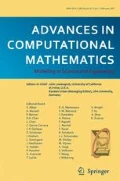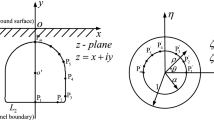Abstract
Time–domain Maxwell's equations are studied for the electromagnetic scattering of plane waves from an arbitrarily shaped cavity filled with nonhomogeneous medium. A transparent boundary condition is introduced to reduce the problem to the bounded cavity. Existence and uniqueness of the model problem are established by a variational approach and the Hodge decomposition. The analysis forms a basis for numerical solution of the model problem.
Similar content being viewed by others
References
A. Alonso and A. Valli, Some remarks on the characterization of the space of tangential traces of H (rot, Ω) and the construction of an extension operator, Manuscripta Math. 89 (1996) 159-178.
H. Ammari, G. Bao and A. Wood, A cavity problem for Maxwell's equations, submitted.
C. Amrouche, C. Bernardi, M. Dauge and V. Girault, Vector potentials in three-dimensional nonsmooth domains, Math. Methods Appl. Sci., to appear.
K.J. Bathe, Finite Element Procedures in Engineering Analysis (Prentice-Hall, Englewood Cliffs, NJ, 1982).
J.P. Berenger, A perfectly matched layer for the absorption of electromagnetic waves, J. Comput. Phys. 114 (1994) 185-200.
D. Colton and R. Kress, Inverse Acoustic and Electromagnetic Scattering Theory, Applied Mathematical Sciences, Vol. 93, 2nd ed. (Springer, New York, 1998).
L. Demkowicz and P. Monk, Discrete compactness and the approximation of Maxwell's equations in R3, preprint (2000).
M. Eller, V. Isakov, G. Nakamura and D. Tataru, Uniqueness and stability in the Cauchy problem for Maxwell's and elasticity systems, in: College de France Seminar, Research Notes in Mathematics, Vol. 14, eds. D. Cioranescu and J.L. Lions (Chapman & Hill/CRC, New York) to appear.
S.D. Gedney and U. Navsriwala, An unconditionally stable finite element time-domain solution of the vector wave equation, IEEE Microwave Guided Wave Lett. 5 (1995) 332-334.
V. Girault and P.A. Raviart, Finite Element Methods for Navier-Stokes Equations. Theory and Algorithms (Springer, New York, 1980).
D. Givoli, Numerical Methods for Problems in Infinite Domains (Elsevier, New York, 1992).
D. Givoli and D. Cohen, Nonreflecting boundary conditions based on Kirchhoff-type formulae, J. Comput. Phys. 117 (1995) 102-113.
M. Grote and J.B. Keller, Exact nonreflecting boundary conditions for the time dependent wave equation, SIAM J. Appl. Math. 55 (1995) 280-297.
M. Grote and J.B. Keller, Nonreflecting boundary conditions for time dependent wave equation, J. Comput. Phys. 127 (1996) 52-65.
C. Hazard and M. Lenoir, On the solution of time-harmonic scattering problems for Maxwell's equations, SIAM J. Math. Anal. 27 (1996) 1597-1630.
J.M. Jin, The Finite Element Method in Electromagnetics (Wiley, New York, 1993).
A. Kirsch and P. Monk, A finite element/spectral method for approximating the time-harmonic Maxwell system in R3, SIAM J. Appl. Math. 55 (1995) 1324-1344.
A. Kirsch and P. Monk, Corrigendum to “A finite element/spectral method for approximating the timeharmonic Maxwell system in R3” (SIAMJ. Appl. Math. 55 (1995) 1324-1344), SIAMJ. Appl. Math. 58 (1998) 2024-2028.
K.S. Komisarek, N.N. Wang, A.K. Dominek and R. Hann, An investigation of new FETD/ABC methods of computation of scattering from three-dimensional material objects, IEEE Trans. Antennas Propag. 47 (1999) 1579-1585.
R. Kress, Linear Integral Equations, 2nd ed. (Springer, New York, 1999).
J. Lee, R. Lee and A. Cangellaris, Time-domain finite element methods, IEEE Trans. Antennas Propag. 45 (1997) 430-442.
R. Leis, Initial Boundary Value Problems in Mathematical Physics (Wiley, New York, 1988).
G. Strang and G. Fix, An Analysis of the Finite Element Method, 2nd ed. (Wellesley/Cambridge Press, New York, 1988).
M. Taylor, Pseudodifferential Operators and Nonlinear PDE (Birkhäuser, Boston, 1991).
L.L. Thompson and R. Huan, Computation of transient radiation in semi-infinite regions based on exact nonreflecting boundary conditions and mixed time integration, J. Acoust. Soc. Amer. 106 (1999) 3095-3108.
L.L. Thompson and R. Huan, Computation of far field solutions based on exact nonreflecting boundary conditions for the time-dependent wave equation, Comput. Methods Appl. Mech. Engrg., to appear.
L.L. Thompson and R. Huan, Implementation of exact nonreflecting boundary conditions in the finite element method for the time-dependent wave equation, Comput. Methods Appl. Mech. Engrg., to appear.
C. Weber, A local compactness theorem for Maxwell's equations, Math. Methods Appl. Sci. 2 (1980) 12-25.
W.L. Wood, Practical Time-Stepping Schemes (Clarendon Press, London, 1990).
O.C. Zienkiewicz and R.L. Taylor, The Finite Element Method. Solid and Fluid Mechanics. Dynamics and Non-Linearity, Vol. II, 4th ed. (McGraw-Hill, New York, 1991).
Author information
Authors and Affiliations
Rights and permissions
About this article
Cite this article
Van, T., Wood, A. Analysis of Time–Domain Maxwell's Equations for 3-D Cavities. Advances in Computational Mathematics 16, 211–228 (2002). https://doi.org/10.1023/A:1014489832230
Issue Date:
DOI: https://doi.org/10.1023/A:1014489832230




